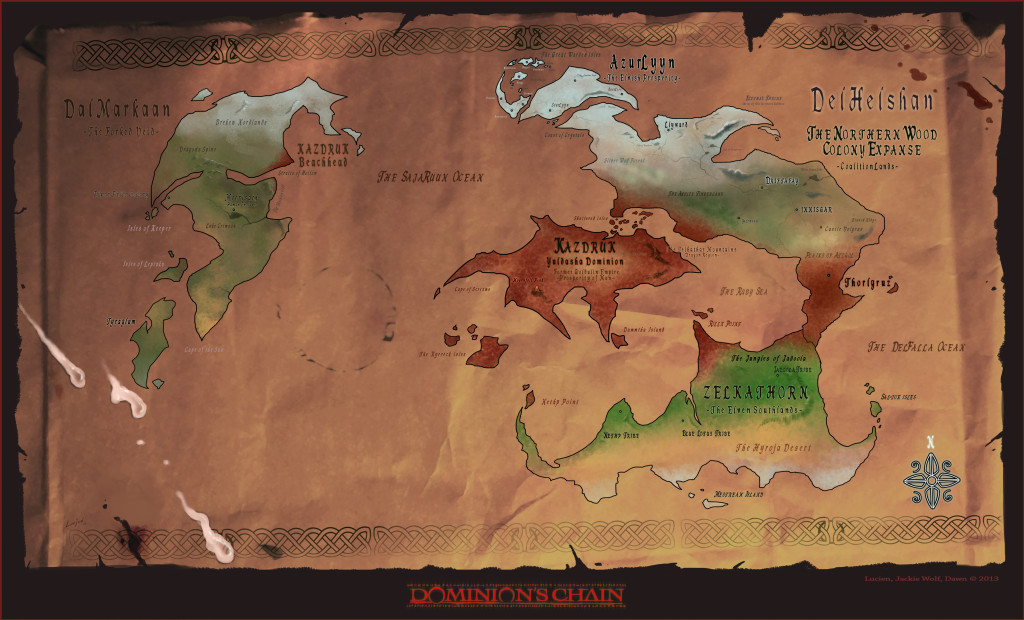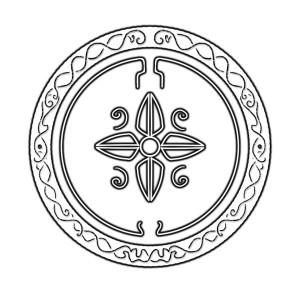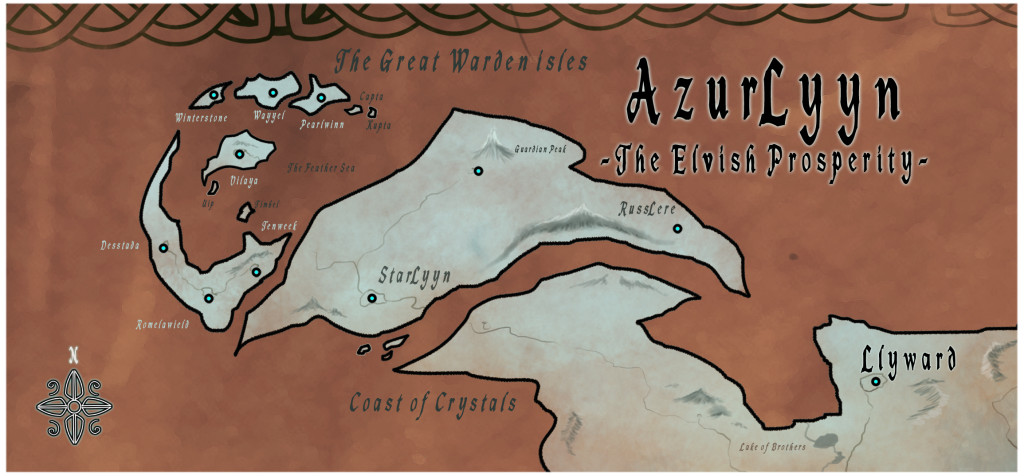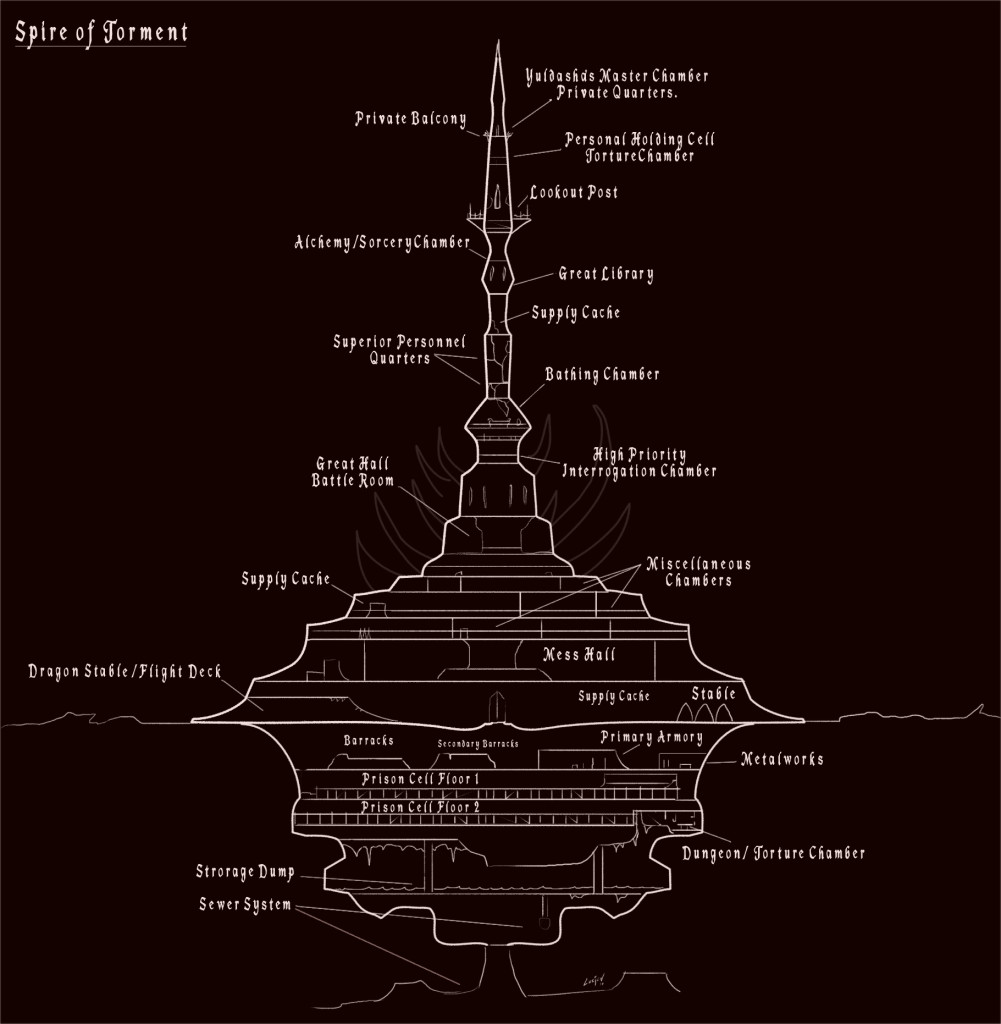Click to Enlarge
Map is subject to change and updates.
DelHelshan
The North Eastern Continent of DelHelshan consists of the Northern Elven region AzurLyyn. The Mid-lands Consist of the Northern Wood Colony Expanse ( The Coalition) and the Southern tip now Kazdruk occupied Thorlgruz.
After the fall of The Goldulin Empire, DelHelshan became the primary opposition and objective of Yuldasha’s led, Kazdruk forces. Thorlgruz andThe Plains of Atzgol where quickly conquered by Kazdruk forces. Led by the ambitious Demon Aeltha. The region was quickly decimated. Theories and reports point to unorganized disarray among the Coalition forces. Reports of disagreements between the multiple Elven clans involved led to the swift fall of the Thorlgruz region. The questionable retreat and orders by Telva Wintersone brought forth the destruction of Lillium’s Cozlak Clan leading to her capture and later corruption.
Northern Wood Colony Expanse: The Coalition
The Northern Wood Colony Expanse. Also known as “The Coalition” or simply “The Colonies” is a grouping of smaller states, clans and factions. The Coalition consist of most of DelHelshan. The great gathering was created after the occurrence of the demons six years ago, to help better protect themselves after the dreadful fall of The Goldulin Empire.
Although never at war with one another. Many tribes and clans rivaled with each other. Making the grouping a bit rocky the first few years. Infighting and power struggles among many of the noble and royal houses were all to common.
The Gathered Leaves. The Northern Wood Colony Expanse Emblem
AzurLyyn: The Elvish Prosperity
The Northern most region and Holy Land of the proud Northern Elves.
AzurLyyn is a grouping of large islands holding major Political and Royal Elven Houses. The three most prominent and influential house are: Winterstone, Wayyel and Pearlwinn.
AzurLyyn: The Elvish Prosperity.
The Kazdruk Occupation Zone: The Former Goldulin Empire
The Goldulin Empire was once a sprawling fertile grassland that used to consist of beautiful cities and lush fields. The area consisted of many human villages. When the Kazdruk arrived the cities and small villages were quickly and violently leveled. Decimating the Humans, their armies and support routes. Those few who survived or weren’t captured, fled Northeast towards DelHelshan. It is now a massive area of desert known as the The Tortured Sea. A barren desolate sea of crimson dunes and harsh sandstorms. Yuldasha’s great Spire sits within the center of the dangerous region.
Kazdruk Spire
Zelkathorn: The Elvish Southlands
Located in the Southern most region.
The dense jungle areas of Zelkathorn is a treacherous and hazardous area.
Every branch, shrub and oversized leaf may hold deadly creatures behind them.
Exotic, poisonous vegetation flourishes wildly and giant man eating plants scatter the overgrown tropical forests. Still some Elvish tribes have grown and adapted to living in this extreme area. The major tribes consist of The Jadoola Tribe, The Blue Lotus Tribe and The Nethp Tribe. Unlike their Northern elvish cousins The Zelkathorn people have tried hard to remain neutral in the demon conflict. but recently have been forced into it. Their natural habitat makes them a difficult target for the Kazdruk forces to reach.
DalMarkaan
DalMarkaan is the western continental landmass of the known world, and one of the two major continents. The SajaRuun Ocean separates DalMarkaan from DelHelshan, the eastern continental landmass. The continent is divided into two parts, the northern area and the southern area. Legend has it that the northern and southern part of DalMarkaan had once been a coherent surface, and that a war of ancient gods had resulted in the continent’s disruption by heavy earthquakes and the emergence of the Dragon’s Spine mountains which nowadays separates the veld. The above mentioned legend is also the source for the continent’s title “The Forked Veld”.
The northern part of DalMarkaan consists of the Breken Nordlands, a snow- and ice-covered region. Another location of interest is the soon emerging Kazdruk Beachhead at the eastern coastline, north of the Straits of Hollow.
The Dragon’s Spine mountains separate the northern part from the southern part of DalMarkaan. While the eastern waters of the Straits of Hollow are accessible by ship, the western sea gate is as good as impossible to access by ship. The reason herefor is the dangerous currents around its entrance and around the Isles of Keeper.
The southern tip of DalMarkaan is accompanied by the Isles of Leptaka, as well as the large isle of Tyraglum. The climate around the Cape of the Sun is hot and dessert-like.
Breken Nordlands
The Breken Nordlands engross almost one half of northern DalMarkaan. The climate is arctic. The constant stream of high winds keeps the air dry. The surface of the Breken Nordlands covered with perpetual ice and snow. The area seems to be uninhabited, but appearances are deceptive.
The north-eastern land tongue of the Breken Nordlands is completely uninhabited. The steep coast line consists of perpetual ice as well. The Wanderes of SajaRuun have one of their few harbors holed into the icy coast. It is unknown if this ice cave harbor is connected to the Nordlanders’ tunnel network, or not.
One of the main characteristics of the Breken Nordlands are the White Towers. They are twenty meters high at an average and have a conic shape. They are hollow and lead either into one of the underlying citadels, or into the vast network of tunnels which connect the various citadels.
The people inhabiting the area are called the Nordlanders. They live underground in citadels in nearly total darkness. Legend has it that they had decided to isolate themselves from the surface of the world, generations ago, in order to properly worship their dark gods. Their society consists of of a clan-like structure, and each clan is lead by a shamanic warrior, usually the strongest of the clan. Living underground in darkness for generations has left a mark on their kind: They are rumored to be altered humanoids, mutated, degenerated and wicked. Their skin color is rumored to be dark, almost obsidian. They also seem to have the ability to see in total darkness. The Nordlanders prefer to stay on their own. Attempt to get in contact with them have always been answered with deceptive and lethal force in the past.
Dragon’s Spine
The mountains separate the northern landmass of DalMarkaan from the southern one. They are the highest mountains of all of DalMarkaan. A mountain pass leads through the highly jointed rock formations, but most of the travelers and caravans avoid this route. The mountains are dragon territory, at least according to legend.
The Scytar Nomad Tribes
Hailing from the Hyroja desert, the Scytar people have no settled homes. Living out of Yurts and tents they follow the herds of horses and antelope that manage to dwell in the harsh landscape. They know the terrain well, and are ruthless to any who would invade, but are kind and hospitable to guests that may be lost.
Seen as savages by other cultures, they embrace this notion, keeping themselves isolated from the world to keep their precious steppes and deserts safe.
Their culture is egalitarian and the tribes are led by a Shaman. Occasionally there will be need for war, and warriors from multiple tribes will come together to form a War Host, led by a Shaman and commanded by a Serok, a rank that exists only in a War Host, and is chosen by the Shaman.
Warriors of exceptional skill can be chosen to be shawrapaht. These become blood tied to a shaman, and act as their protectors. Shawrapaht have no family, no marriages, and can bear no children. They must be dedicated fully to the Tribe or War Host, and the Shaman that leads them. This does not mean they cannot take lovers or journey on their own however. Shamans often send their shawrapaht away to fulfill other duties.
The Wanderers of SajaRuun
Known aliases: The Seafarers of SajaRuun, The Nomads of the Ocean, The Sea-Born
Historiography: The Wanderers of SajaRuun are officially chronicled as native inhabitants of the SajaRuun ocean since Sun Cycle 46. It is rumored that the SajaRuun ocean has its name been given from them.
Socitey structure: The Wanderes of SajaRuun’s social structure is purely based upon their capital ships and the associated on-board population. Each capital ship froms its own government unit. There is no single ruler or centralized government standing above the ships, no king or queen, no president, etc. This distributed system of governance makes the Wanderers of SajaRuun hard to be targeted entirely, especially when it comes to conflicts. Their social structure could be compared to a P2P network, granting everyone of its members a high level of independance.
Capital ship population: A capital ship each has a captain on top of the chain of command, followed by a the crew of the ship. Some of the crew maintain officer ranks and thus work as a relais between the ship’s captain and the crew. The crew is responsible for operating the ship. The remaining part of a capital ship’s population consists of the passengers. Passengers are divided into two groups, native passengers and temporary passengers. Native passengers inhabit the ship, but they have nothing to do with the ship’s operation. They live on-board and offer non ship-related services such as catering, barbershops, schools, etc. All of the native passengers of a ship are bound by instructions. All temporary passengers, those who are just transoprted from one point to another, have more freedom, but still have to stick to a set of special rules for external passengers. A capital ship has an average crew size of 2000 members and a native population count of about 800 people. It has a capacity for transporting up to 6200 external passengers.
Capital ship support vessels: A capital ship usually is accompanied by an armada of smaller vessels, usually sailing vessels ranging from frighters to armed corvettes, etc. One of the main purposes of the armada besides protecting and supplying the capital ship is to transfer passengers and goods from the land to the capital ship and vice versa. A capital ship never lands at a coast or harbor, it always remains anchored offshore, away from coastal waters. The armada of a capital ship is bound to its mother vessel; every supply ship is tagged with the nationality marking of its mother vessel. The captain of a supply vessel commands the ship, yet has to take up a subordinate role to a capital ship’s captain.
Capital ship structural geometry: A capital ship is a giant catamaran, a multi-hulled vessel consisting of two parallel hulls of equal size. A typical capital ship has a length of about 320 meters and a wide beam of about 100 meters, from which the vessel derives its geometry-stability. The two hulls of a capital ship enable it to heel much less than a monohull vessel. The limited heeling means the ride on a capital ship is more comfortable for passengers and crew. The two hulls of a capital ship are joined by a sophisticated structure combining accomodation into the bridging superstructure. Capital ships are made of wood and metal structures, while the majority of the vessel’s body is made of wood, restrenghthened by metal layers and frames.
Capital ship mundane technology: A capital ship is no sailing vessel; it is driven by a large single paddle wheel to propel the craft through the water. The paddle wheel is mounted on the rear of the ship, between the two hulls of the vessel. It is a large steel framework wheel, its outer edge fitted with with numerous, regularly-spaced paddle blades. The wheel is rotated by two mage-stone engines. Those magically enhaced devices are located in the rear section of each hull, together with a sophisticated combination of chains, levers and cog-wheels for moving the rudder, one at the aft of each hull. The main deck of a capital ship carries a variety of windmils, usually ten, five on top of the starboard hull and five on top of the portside hull. The upper section of a windmill which carries the winged wheel is capable of rotating around its vertical axis and thus can be turned to face the wind’s direction. A series of axises and cog-wheels translate the wind’s power into kinetic rotation energy, which is directly lead over to the mage-stone engines.
Capital ship magic technology: The core element of a capital ship’s propulsion technology is the mage-stone boulder. This large piece of rock is capable of storing elemental magical energy, which can be implemented by powerful magic rituals for example. Once empowered with elemental magic, the mage-stone boulder is split into two halves. Both halves now behave like two magnets; they remain sticking together and only can be separated with force. Further more, even when separated, but still in direct vicinity to each other, one half of the boulder always maintains a relative position toward its other half. For example, if you start to turn the one half around a certain axis, the other half will do the same. This is the basic principle behind the mage-stone engine. Part one of the boulder is directly connected to the ship’s paddle wheel through a massive axis. Part two of the boulder is connected to the windmills. Another beneficial factor of the mage-stone engine is that the boulders are capable of storing magic energy. This means that the windmills can charge the mage-stone with rotation energy while the capital ship is standing still, and it can release the stored magical energy to the paddle wheel during still air. This enables a capital ship to always be maneuverable.
Belief and deities: The Wanderes of SajaRuun believe in “Siramaar”, the spirit of the water. It is their belief that the water, especially the ocean, is the cradle of mankind, that life itself has begun inside the water in ancient times. Siramaar, the spirit of the water, also has descendants called “Aramaar”, the children of the water, who make contact to the Wanderes of SajaRuun once a generation in oder to find a new spiritual human mate and reproduce.
The Aramaar: An Aramaar is a humanoid hybrid creature, having both lungs and gills in order to be able to live on the world’s surface, as well as in the water. Their gills are located on the sides of their torso. They are true hermaphrodites and thus have both male and female genitalia, primary and secondary sexual characterstics alike. An Aramaar is a humanoid creature with two legs and two arms and has a silverish scaled skin with traces of blue, as well as a very sleek skin texture. They have webbed fingers and toes, as well as prehensile tail which can be used as a fin for swimming under water. The joints of their limbs are much more flexible than those of an ordinary human, granting them the ability to swim and dive masterfully. They have no bodily hair, yet a variety of tentacles covering their head, granting them an alomst human appearance. Aramaar have human-like faces with slightly larger eyes and long pointed ears, but without noses and nostrils. Their eyes are usually silver-colored and covered with a nictitating membrane. They possess a unique ability: They are capable of contacting and communicating other Aramaar telepathically (magically) through the water. Having this ability, the Aramaar can share their thoughts with others of their kind, providing a highly efficient communication network through the ocean. The Aramaar are considered holy and are clouded by a certain veil of mystery, due to the fact that their only contact to human beings is through a capital ship’s captain.
The captain’s bond: Once a generation, the Wanderers of SajaRunn conduct a sacred ritual in which young children have the chance to be blessed by Siramaar to become a capital Ship’s captain. The ritual is done on the open sea and contains the summoning of a young Aramaar. If the Aramaar chooses one of the children to stay with, the human child is considered to be a chosen one. A chosen one’s training begins with the establishment and fortification of a soul bond with the Aramaar, called the captain’s bond. Once the bond is established, the chosen child and the young Aramaar will stay together for the rest of their lives. If one of the partners die, the other one will die shortly afterwards. After a short time, the bond becomes a profound connection between the two partners, which can be temporarily strengthened through physical contact. The intensity of the strengthened bond depends on the form of contact; the more intimate the contact is, the stronger the connection will be. The Aramaar’s nature of being hermaphrodites is beneficial here; they can become intimate with women and men alike. Aramaar are very passoinate being; they often seek to be with their partner for moree than just communicational purposes.
The Wanderers of SajaRuun’s role in the Dominion’s Chain world: Their sovereign territory was and is the SajaRuun ocean between the western continent of DalMarkaan and the eastern landmasses of DelHelshan. Foreign ships are granted to travel through their domain, they do not claim to have a monopoly on seafaring. However, mercantile ships have to register their lading before they set sails. The Wanderes of SajaRuun treasure their political independance and do not meddel in the landman’s affairs. Where others see the war, the seafarers see chances. Their services as transporters and suppliers are legendary, as well as their stoci ability to stay out of other’s foreign affairs. The Kazdruk invasion of the former Goldulin empire, their expansion plans, as well as their planned invasion of DalMarkaan, are met with reserved interest. Since they do not depend on interacting with landmen at all, the Wanderers of SajaRuun will not interfere with the recent events, as long as their home domain remains untouched.





Have you named the world being invaded or the Kazdruk homeworld yet?
I’d really Love to know.